We only work with the highest quality components in order to provide you with long-lasting jewels that will endure the test of time.
Here's the list of materials we work with and a short description of their respective origins and characteristics.
Precious Metals
A precious metal is a rare, naturally occurring metallic chemical element of high economic value.
-
Sterling Silver
 Sterling silver is classified as .925 sterling or 92.5% pure. This means that sterling silver is an alloy of silver and another metal, usually copper. This is done to ensure strength and durability, as fine silver .999 pure or 99.9% sterling, is too soft for any functional use. We use only lead and nickel-free silver at Larissa’s Jewels.
Sterling silver is classified as .925 sterling or 92.5% pure. This means that sterling silver is an alloy of silver and another metal, usually copper. This is done to ensure strength and durability, as fine silver .999 pure or 99.9% sterling, is too soft for any functional use. We use only lead and nickel-free silver at Larissa’s Jewels.
Sterling has a tendency to oxidize, which is normal, and can be gently polished with the cloths available for purchase on our site. Wearing sterling frequently can coat it in one’s natural oils and prevent some of the tarnish over time. As with all our jewelry, protecting it from hairspray, perfume and other chemicals will help to preserve it’s lustre and increase it’s longevity. Do not wear our jewelry in a pool or expose it to chlorine and other chemicals.
-
Gold Vermeil (Vermeille)
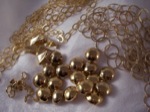 Gold vermeil, pronounced ver-may, is anywhere from 10K gold to 24K gold over sterling silver. It is at least two and one-half microns in thickness over the sterling. This is a thick coat over the sterling, for longer wear. Generally, we use 24K gold vermeil at Larissa’s Jewels.
Gold vermeil, pronounced ver-may, is anywhere from 10K gold to 24K gold over sterling silver. It is at least two and one-half microns in thickness over the sterling. This is a thick coat over the sterling, for longer wear. Generally, we use 24K gold vermeil at Larissa’s Jewels.
It can come in rose/pink gold, yellow and white gold. The origins of vermeil are in France, in the 1700’s. As with sterling silver, since the gold is over sterling, gold vermeil pieces can oxidize and care should be taken not to spray hairspray, perfume and other chemicals, such as exposure to chlorine. Do not have the gold vermeil pieces polished at a jeweler’s as it may remove some of the thick gold overlay. You may use a soft, clean, lint-free cloth (such as those designed for eye-glasses) to buff the jewelry. Cloths that are meant for sterling may have a too strong chemical embedded and may affect the gold.
-
Gold Filled
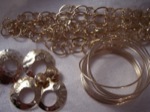 Gold filled is also known as rolled gold. It is created by a process of a base metal (usually pure copper) covered by sheets of gold (usually 14K gold or more) and rolled mechanically to have a thick content of 14K gold or more, throughout the piece. The durability and hypo-allergenic qualities are very good. The durability of the gold is better than simple gold-plate. Most people with skin sensitivities should have no issue with 14K gold-filled jewelry.
Gold filled is also known as rolled gold. It is created by a process of a base metal (usually pure copper) covered by sheets of gold (usually 14K gold or more) and rolled mechanically to have a thick content of 14K gold or more, throughout the piece. The durability and hypo-allergenic qualities are very good. The durability of the gold is better than simple gold-plate. Most people with skin sensitivities should have no issue with 14K gold-filled jewelry.
-
Rhodium Plated
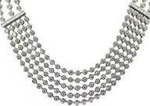 Rhodium is a silvery-white metal and part of the platinum group. It is exceptionally resistant to corrosion and as such is used to plate over sterling silver and often white gold as well. When plated over white gold, it improves it’s appearance and over sterling silver, it helps dramatically against tarnish. It can sometimes give an antiqued look to sterling silver as well. We at Larissa’s Jewels use mainly rhodium over sterling, unless otherwise stated.
Rhodium is a silvery-white metal and part of the platinum group. It is exceptionally resistant to corrosion and as such is used to plate over sterling silver and often white gold as well. When plated over white gold, it improves it’s appearance and over sterling silver, it helps dramatically against tarnish. It can sometimes give an antiqued look to sterling silver as well. We at Larissa’s Jewels use mainly rhodium over sterling, unless otherwise stated.
Pearls
A pearl is a hard object produced within the soft tissue (specifically the mantle) of a living shelled mollusk. Just like the shell of a mollusk, a pearl is made up of calcium carbonate in minute crystalline form, which has been deposited in concentric layers.
-
Swarovski Pearls
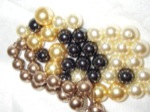 Swarovski pearls are simulated pearls. They are uniquely consistent and have a glass core, which makes them slightly heavier. They are very scratch-resistant and have an ability to withstand exposure to hairspray, perfumes and other abrasives which can be very damaging to genuine pearls.
Swarovski pearls are simulated pearls. They are uniquely consistent and have a glass core, which makes them slightly heavier. They are very scratch-resistant and have an ability to withstand exposure to hairspray, perfumes and other abrasives which can be very damaging to genuine pearls.
-
Freshwater Pearls
 Freshwater pearls, also known as cultured freshwater pearls are cultivated in Japan, the United States and China.These are cultured in mussel shells and range greatly in size, shape, colour and price.
Freshwater pearls, also known as cultured freshwater pearls are cultivated in Japan, the United States and China.These are cultured in mussel shells and range greatly in size, shape, colour and price.
-
Natural Pearls
 These pearls are formed in living shelled mollusks. The most valuable pearls occur spontaneously in the wild, but they are extremely rare. These wild pearls are referred to as natural pearls. Cultured and farmed pearls make up the majority of the pearls sold today. They come from Pearl Oysters as well as mussels, as above in Freshwater Pearls. The majority of saltwater cultured pearls are grown with beads. The trade name of the cultured pearls are Akoya, white or golden south sea, and black Tahitian.
These pearls are formed in living shelled mollusks. The most valuable pearls occur spontaneously in the wild, but they are extremely rare. These wild pearls are referred to as natural pearls. Cultured and farmed pearls make up the majority of the pearls sold today. They come from Pearl Oysters as well as mussels, as above in Freshwater Pearls. The majority of saltwater cultured pearls are grown with beads. The trade name of the cultured pearls are Akoya, white or golden south sea, and black Tahitian.
The majority of beadless cultured pearls are mantle-grown in freshwater shells in China, known as freshwater cultured pearls. Akoya pearls are quite expensive, but sometimes used in pieces at Larissa’s Jewels and, as always, by custom order as well.
Additional Distinctive Materials
-
Coral
 Coral is a material that is actual a marine animal. They form tree-like structures and although there are 2000 types of coral, very few are at risk of extinction. The risk of extinction is not from the jewelry industry in particular. None of the coral used at Larissa’s Jewels is of an endangered variety. We use sponge coral (in classic red/coral tones) as well as blue sponge coral. We also use some noble coral, in the traditional red/coral hues.
Coral is a material that is actual a marine animal. They form tree-like structures and although there are 2000 types of coral, very few are at risk of extinction. The risk of extinction is not from the jewelry industry in particular. None of the coral used at Larissa’s Jewels is of an endangered variety. We use sponge coral (in classic red/coral tones) as well as blue sponge coral. We also use some noble coral, in the traditional red/coral hues.
-
Shell
 Mother of pearl, abalone shell, river shell are all used at Larissa’s Jewels. They have a variety of natural and dyed colours and often have a pearly nacre which is highly appealing. They provide dazzling impact without adding too much weight to a piece.
Mother of pearl, abalone shell, river shell are all used at Larissa’s Jewels. They have a variety of natural and dyed colours and often have a pearly nacre which is highly appealing. They provide dazzling impact without adding too much weight to a piece.
-
Swarovski Crystals
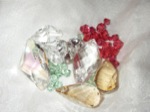 Swarovski Crystal Elements are used in many pieces of Larissa’s Jewels collection. The quality and unique cuts and shapes are simply stunning. They are a company that has been around since the 1890’s, the craftsmanship keeps improving and they are always innovating.
Swarovski Crystal Elements are used in many pieces of Larissa’s Jewels collection. The quality and unique cuts and shapes are simply stunning. They are a company that has been around since the 1890’s, the craftsmanship keeps improving and they are always innovating.
-
Wood
 There are so many types of natural wood and seeds from all over the world, and we use woods and seed pods that are in bead form. They provide incredible textural quality and range in sizes and we make every attempt to never use endangered species. Many of the seed pods are waste material and native small businesses drill holes and re-use a product that would otherwise be discarded.
There are so many types of natural wood and seeds from all over the world, and we use woods and seed pods that are in bead form. They provide incredible textural quality and range in sizes and we make every attempt to never use endangered species. Many of the seed pods are waste material and native small businesses drill holes and re-use a product that would otherwise be discarded.
Mohs’ Scale of Hardness
The Mohs’ scale of mineral hardness is the scale most commonly used by gemologists. It arranges minerals in order of their ‘scratchability’ from the softest to the hardest, diamond.

Semi-precious and Precious Gemstones (and their Moh's scale factor)
A gemstone or gem (also called a precious or semi-precious stone, a fine gem, or jewel) is a piece of mineral, which, in cut and polished form, is used to make jewelry or other adornments. However certain rocks, (such as lapis lazuli) and organic materials (such as amber or jet) are not minerals, but are still used for jewelry, and are therefore often considered to be gemstones as well.
-
Agate, 6.5 - 7.0
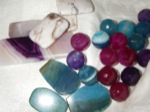 Agate comes in many different forms and colours. It is a microcrystalline variety of silica. It falls into the chalcedony / agate family of gemstones. It is a semi-precious stone and we use a multitude of varieties here at Larissa’s Jewels.
Agate comes in many different forms and colours. It is a microcrystalline variety of silica. It falls into the chalcedony / agate family of gemstones. It is a semi-precious stone and we use a multitude of varieties here at Larissa’s Jewels.
-
Amber, 2.0 - 2.5
 Although considered a gemstone, and having been used for thousands of years, it is actually fossilized tree resin, having come from trees over 50 million years ago. There is much history to Amber and the uses for it in gems and in healing are fascinating. It ranges in colour and size from pale yellow to cognac and red toned. Much of the best quality comes from the Baltic Sea.
Although considered a gemstone, and having been used for thousands of years, it is actually fossilized tree resin, having come from trees over 50 million years ago. There is much history to Amber and the uses for it in gems and in healing are fascinating. It ranges in colour and size from pale yellow to cognac and red toned. Much of the best quality comes from the Baltic Sea.
-
Amethyst, 7.0
 Amethyst falls into the category of quartz. This is the largest category of gemstones and has a vast number of types. Amethyst can be found in all shades of purple. It ranges from rose and light lavender to intense Siberian or deep purple.
Amethyst falls into the category of quartz. This is the largest category of gemstones and has a vast number of types. Amethyst can be found in all shades of purple. It ranges from rose and light lavender to intense Siberian or deep purple.
-
Aquamarine, 7.5 - 8.0
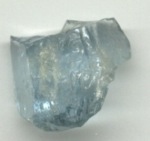 Aquamarine is a blue or turquiose form of Beryl. Also in the beryl family are the exquisite Emerald, Morganite and Bixbite.
Aquamarine is a blue or turquiose form of Beryl. Also in the beryl family are the exquisite Emerald, Morganite and Bixbite.
-
Beryl, 7.5 - 8.0
 Beryl has a large mix or gemstones. Famously emerald, aquamarine, morganite, heliodor,bixbite and goshenite are part of this family. Emerald is a deep green, sometimes with a blue tint. Aquamarine has a great range of colours, sea green, sky blue and dark blue. Morganite (or pink beryl) ranges from soft peach to rose-pink to apricot. Heliodor (yellow beryl) ranges from pale lemon yellow to yellow-green and a rich gold. Bixbite (red beryl) is very rare. It is a deep red colour. Goshenite has no colouring agents and sometimes has needle-like inclusions and can cometimes be confused with white topaz.
Beryl has a large mix or gemstones. Famously emerald, aquamarine, morganite, heliodor,bixbite and goshenite are part of this family. Emerald is a deep green, sometimes with a blue tint. Aquamarine has a great range of colours, sea green, sky blue and dark blue. Morganite (or pink beryl) ranges from soft peach to rose-pink to apricot. Heliodor (yellow beryl) ranges from pale lemon yellow to yellow-green and a rich gold. Bixbite (red beryl) is very rare. It is a deep red colour. Goshenite has no colouring agents and sometimes has needle-like inclusions and can cometimes be confused with white topaz.
-
Carnelian, 6.0 - 7.0
 Carnelian, also called cornelian, is a brownish red to orange mineral which falls into the Chalcedony / Agate family of stones. It is a very ancient stone and used in antique jewelry and ancient seals from Roman times.
Carnelian, also called cornelian, is a brownish red to orange mineral which falls into the Chalcedony / Agate family of stones. It is a very ancient stone and used in antique jewelry and ancient seals from Roman times.
-
Chalcedony, 6.5 - 7.0
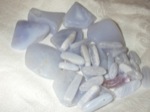 Chalcedony is the name given to the group of microcrystalline form of silica composed of quartzes where the crystals appear as a solid mass. There are solid-coloured stones and many with banding, such as the agates, as above. Chalcedony, Carnelian, Onyx, Bloodstone and Jasper all fall into this category.
Chalcedony is the name given to the group of microcrystalline form of silica composed of quartzes where the crystals appear as a solid mass. There are solid-coloured stones and many with banding, such as the agates, as above. Chalcedony, Carnelian, Onyx, Bloodstone and Jasper all fall into this category.
-
Chrysoberyl, 8.5
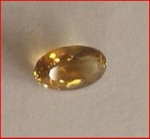 Chrysoberyl has two of the most important gemstones: Alexandrite and Chrysoberyl cat’s eye. Chrysoberyl is normally yellow, yellow-green, or brownish with its color being caused by the presence of iron. The Alexandrite variety displays a color change (alexandrite effect) dependent upon the nature of ambient lighting. The colours can be yellow, blue-green, pink and deep raspberry, with the change in colur as described above.
Chrysoberyl has two of the most important gemstones: Alexandrite and Chrysoberyl cat’s eye. Chrysoberyl is normally yellow, yellow-green, or brownish with its color being caused by the presence of iron. The Alexandrite variety displays a color change (alexandrite effect) dependent upon the nature of ambient lighting. The colours can be yellow, blue-green, pink and deep raspberry, with the change in colur as described above.
-
Citrine, 7.0
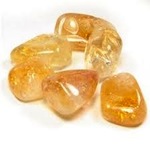 Citrine is part of the quartz family. It is a stone that ranges in color from pale yellow to pale orange to brown. It often is confused with yellow/gold versions of topaz, since they are both recognized as the birthstone for November.
Citrine is part of the quartz family. It is a stone that ranges in color from pale yellow to pale orange to brown. It often is confused with yellow/gold versions of topaz, since they are both recognized as the birthstone for November.
-
Corundum, 9.0
 Corundum has some of the most highly prized gemstones in it’s family, Ruby and Sapphire. These range in colour and shape dramatically.
Corundum has some of the most highly prized gemstones in it’s family, Ruby and Sapphire. These range in colour and shape dramatically.
-
Diamond, 10.0
 Widely recognized as the most lovely of all gemstones, they range in colour and shape and size. The value of diamonds in the colourless form remains very high, but there is increasing value to certain ‘trendy’ colours available.
Widely recognized as the most lovely of all gemstones, they range in colour and shape and size. The value of diamonds in the colourless form remains very high, but there is increasing value to certain ‘trendy’ colours available.
-
Feldspar, 6.0 - 6.5
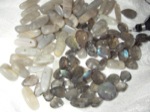 Two types of Feldspar are Moonstone and Labradorite. These stones have very beautiful schiller or opalescence. Labradorite is named after it’s main source, Labrador, Canada.
Two types of Feldspar are Moonstone and Labradorite. These stones have very beautiful schiller or opalescence. Labradorite is named after it’s main source, Labrador, Canada.
-
Fluorite, 4.0
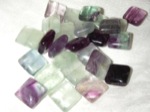 This is a stone that is very appealing because of the range of colours available and shapes as well. The colours range from golden yellow to blue-green to deep purple.
This is a stone that is very appealing because of the range of colours available and shapes as well. The colours range from golden yellow to blue-green to deep purple.
-
Garnet, 6.5 - 7.5
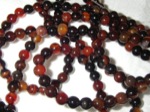 These are a long-time favorite gemstone. They have a broad spectrum of colours and price points as well. The familiar red-orange-brown tones to bright green Tsavorite to a bright violet-red of Rhodolite.
These are a long-time favorite gemstone. They have a broad spectrum of colours and price points as well. The familiar red-orange-brown tones to bright green Tsavorite to a bright violet-red of Rhodolite.
-
Goldstone, N/A
 This is actually a type of glittering glass which can be found in 2 colours. One is a deep inky, indigo colour, called blue goldstone and the other is called brown, which has a deep copper colour. The two colours have these shimmering elements (actually copper mixed with other natural materials), which give it a fantastic sparkle. It is said to have been discovered or made by 17th century Italian monks. It has no Mohs scale, since it is technically not a natural stone
This is actually a type of glittering glass which can be found in 2 colours. One is a deep inky, indigo colour, called blue goldstone and the other is called brown, which has a deep copper colour. The two colours have these shimmering elements (actually copper mixed with other natural materials), which give it a fantastic sparkle. It is said to have been discovered or made by 17th century Italian monks. It has no Mohs scale, since it is technically not a natural stone -
Hematite, 5.5 - 6.5
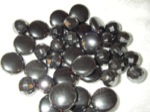 Hematite is a beautiful stone, metallic grey to charcoal in colour. It is also mostly opaque. It was used in the Victorian Era in Europe and has had a recent spike in interest for modern-day jewlers.
Hematite is a beautiful stone, metallic grey to charcoal in colour. It is also mostly opaque. It was used in the Victorian Era in Europe and has had a recent spike in interest for modern-day jewlers.
-
Iolite, 7.0 - 7.5
 Iolite is also known as Cordierite (in minerals) or Dichroite. It can be found in many different colours and the most desirable being a deep blue-violet, rivalling blue sapphires in colour.
Iolite is also known as Cordierite (in minerals) or Dichroite. It can be found in many different colours and the most desirable being a deep blue-violet, rivalling blue sapphires in colour.
-
Jade, 6.5 - 7.0
 Jade is a gemstone with two distinct classifications. One is known as Jadeite Jade and the other Nephrite Jade. Long associated with Chinese culture, they both range in colours. Jadeite Jade is rarer and considered the gem of the two. Jadeite has a a spectrum of deep imperial green to pale lavender and even black and yellow. Nephrite Jade has a crystal structure that is extremely tough and was once used for weapons. It comes from a creamy white to all shades of green.
Jade is a gemstone with two distinct classifications. One is known as Jadeite Jade and the other Nephrite Jade. Long associated with Chinese culture, they both range in colours. Jadeite Jade is rarer and considered the gem of the two. Jadeite has a a spectrum of deep imperial green to pale lavender and even black and yellow. Nephrite Jade has a crystal structure that is extremely tough and was once used for weapons. It comes from a creamy white to all shades of green.
-
Kyanite, 4.5 - 5.0 or 7.0
 Kyanite is a beautiful stone that has a very interesting structure which puts it into 2 hardness categories on the Mohs scale. The most prized colour of Kyanite is a clear royal blue colour.
Kyanite is a beautiful stone that has a very interesting structure which puts it into 2 hardness categories on the Mohs scale. The most prized colour of Kyanite is a clear royal blue colour.
-
Labradorite, 6.0 - 6.5
 This is part of the Feldspar species, as above. It has a beautiful shimmering quality, similar to black opal, and a term called labradorescence is associated with it. Mostly found in grey-black with flashes of different blues. It gets it’s name from it’s main source, Labrador, Canada.
This is part of the Feldspar species, as above. It has a beautiful shimmering quality, similar to black opal, and a term called labradorescence is associated with it. Mostly found in grey-black with flashes of different blues. It gets it’s name from it’s main source, Labrador, Canada.
-
Lapis Lazuli, 5.0 - 6.0
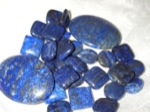 Lapis Lazuli is a favorite gemstone for many and the best quality has a very intense, opaque blue colour often with gold or silver pyrite inclusions which give it some serious sparkle.
Lapis Lazuli is a favorite gemstone for many and the best quality has a very intense, opaque blue colour often with gold or silver pyrite inclusions which give it some serious sparkle.
-
Malachite, 4.0
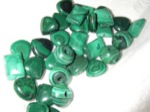 Malachite is a very historic gemstone, so popular with the Russian royal family in the 19th century that they paneled whole rooms with it and Victorians set it in gold. It is known for it’s deep green colour with striations or banding of different greens and black.
Malachite is a very historic gemstone, so popular with the Russian royal family in the 19th century that they paneled whole rooms with it and Victorians set it in gold. It is known for it’s deep green colour with striations or banding of different greens and black.
-
Natural Crystal, 7.0
 Natural Crystal is part of the quartz family. In this instance we refer to this in the clear crystal form we use in jewelry here at Larissa's Jewels. Like many crystals it is said to have healing properties.
Natural Crystal is part of the quartz family. In this instance we refer to this in the clear crystal form we use in jewelry here at Larissa's Jewels. Like many crystals it is said to have healing properties.
-
Opal, 5.5 - 6.5
 It is actually a form of silica related to quartz. Opals are a gemstone that has so many colour variations and often within one stone. Their internal structure is such that they diffract light and can make it seem like many different colours. The range is clear, white, blue,orange, rose, purple, black an shades in between.
It is actually a form of silica related to quartz. Opals are a gemstone that has so many colour variations and often within one stone. Their internal structure is such that they diffract light and can make it seem like many different colours. The range is clear, white, blue,orange, rose, purple, black an shades in between.
-
Peridot, 6.5 - 7.0
 This is a gemstone also known as Olivine. The colour is green, the intensity ranges as does the shade. It is transparent with a wide possibility of inclusions.
This is a gemstone also known as Olivine. The colour is green, the intensity ranges as does the shade. It is transparent with a wide possibility of inclusions.
-
Quartz, 7.0
 This is the largest of all species of gemstones. It has the familiar Amethyst, Smoky Quartz, Citrine (Yellow Quartz), Rose Quartz, Aventurine, Tiger’s Eye, Blue Quartz, Clear and Tourmalinated Quartz and many more. Some varieties are opaque, while others are transparent and show beautiful needle-like colours running through, such as in rutilated quartz and tourmalinated quartz.
This is the largest of all species of gemstones. It has the familiar Amethyst, Smoky Quartz, Citrine (Yellow Quartz), Rose Quartz, Aventurine, Tiger’s Eye, Blue Quartz, Clear and Tourmalinated Quartz and many more. Some varieties are opaque, while others are transparent and show beautiful needle-like colours running through, such as in rutilated quartz and tourmalinated quartz.
-
Rhodochrosite, 4.5 - 5.0
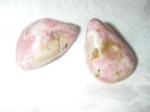 This is a stone with beautiful pink hues, in it’s purest form. It is a very old stone, sometimes called Inca rose, from ancient Incan times. It can also have a range of colours within one stone (such as pendants) with pinks and brown shades.
This is a stone with beautiful pink hues, in it’s purest form. It is a very old stone, sometimes called Inca rose, from ancient Incan times. It can also have a range of colours within one stone (such as pendants) with pinks and brown shades.
-
Spinel, 8.0
 Spinel is a gem that in the past was often confused with Ruby as it is found in the same deposits as Ruby and Sapphire. There is even one in the British Crown Jewels known as the Timur Ruby. It ranges in colour from a deep blue to bright red, pale pink, green, yellow, brown and black.
Spinel is a gem that in the past was often confused with Ruby as it is found in the same deposits as Ruby and Sapphire. There is even one in the British Crown Jewels known as the Timur Ruby. It ranges in colour from a deep blue to bright red, pale pink, green, yellow, brown and black.
-
Spodumene, 6.5 - 7.0
 There is a gemstone in this grouping that is Kunzite. Seen in a range of pinks and purple shades, the rose pinks are the most popular shade.
There is a gemstone in this grouping that is Kunzite. Seen in a range of pinks and purple shades, the rose pinks are the most popular shade.
-
Topaz, 8.0
 The range in colours for Topaz are from colourless to golden orange, pale pink, blue of all shades, green and violet as well. They are commonly heat-treated and are available in many shapes and carats.
The range in colours for Topaz are from colourless to golden orange, pale pink, blue of all shades, green and violet as well. They are commonly heat-treated and are available in many shapes and carats.
-
Tourmaline, 7.0 - 7.5
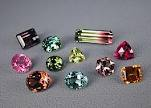 This is a gemstone with many shades available. Depending on the mineral content of the stone the colours are blue-green, pink, red, turquoise, yellow, brown and black. There are even stones known as watermelon Tourmaline since at one end there is pink and greenand at the other end of the same stone they can be blue/green and clear in colour.
This is a gemstone with many shades available. Depending on the mineral content of the stone the colours are blue-green, pink, red, turquoise, yellow, brown and black. There are even stones known as watermelon Tourmaline since at one end there is pink and greenand at the other end of the same stone they can be blue/green and clear in colour.
-
Turquoise, 5.0 - 6.0
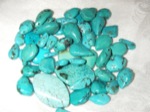 This stone has many historic notions associated with it. It was believed to be lucky in some cultures and worn to protect the wearer from evil. The natural turquoise is very expensive and comes in a range of colours from yellow-green to sea-green and the pretty blue we are all familiar with today. It often has veining or matrix of black or brown throughout.
This stone has many historic notions associated with it. It was believed to be lucky in some cultures and worn to protect the wearer from evil. The natural turquoise is very expensive and comes in a range of colours from yellow-green to sea-green and the pretty blue we are all familiar with today. It often has veining or matrix of black or brown throughout.
-
Zircon, 6.5 - 7.5
 This is a transparent stone that comes in a variety of colours, yellow, brown, orange, violet, green, blue and red. This stone is often confused with Cubic Zirconia, which is a man-made stone. Zircon has two types: high-zircon and low-zircon which differ in hardness and, therfore, durability.
This is a transparent stone that comes in a variety of colours, yellow, brown, orange, violet, green, blue and red. This stone is often confused with Cubic Zirconia, which is a man-made stone. Zircon has two types: high-zircon and low-zircon which differ in hardness and, therfore, durability.
-
Zoisite, 6.5 - 7.0
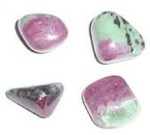 There are yellow and green stones, blue-violet and opaque mutli-cloured stones.This species has a very well-known stone, Tanzanite. This has become a very popular stone for it’s blue-violet colour. There are other stones within this family and one of which is called Thulite which often has beads called ruby-in-zoisite these show a beautiful opaque variation of colour with ruby to pale green.
There are yellow and green stones, blue-violet and opaque mutli-cloured stones.This species has a very well-known stone, Tanzanite. This has become a very popular stone for it’s blue-violet colour. There are other stones within this family and one of which is called Thulite which often has beads called ruby-in-zoisite these show a beautiful opaque variation of colour with ruby to pale green.
Clasps and Closures
We use a variety of clasps and closures here at Larissa’s Jewels, depending on weight of the piece and the preference of the customer. Below are some pictures to show the differences for our customers.
-
 Toggle clasps are usually a large round hole with a bar on the other end and they slide into close easily.
Toggle clasps are usually a large round hole with a bar on the other end and they slide into close easily.
-
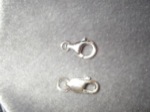 Lobster clasps are like a lobster's claw: when you open the spring, it attaches to a ring on the other end.
Lobster clasps are like a lobster's claw: when you open the spring, it attaches to a ring on the other end.
-
 Fancy clasps, usually box clasps and these range in size and style and material. Generally, you pinch one end and pull it our of the other end of the clasp.
Fancy clasps, usually box clasps and these range in size and style and material. Generally, you pinch one end and pull it our of the other end of the clasp.
-
 Magnetic clasps, sometimes have a screw-in component, but often are just strong magnets. Do not use if you have a pacemaker.
Magnetic clasps, sometimes have a screw-in component, but often are just strong magnets. Do not use if you have a pacemaker.
Earring components
There are 3 types of earring components we use a Larissa’s Jewels. French ear wires, lever-backs and post style.
-
 French ear wires, slide into your pierced ear, and always have a backing to keep them secure and positioned correctly.
French ear wires, slide into your pierced ear, and always have a backing to keep them secure and positioned correctly.
-
 Lever-backs slide into your ear and have the backing attached and it levers onto the back of the lobe.
Lever-backs slide into your ear and have the backing attached and it levers onto the back of the lobe.
-
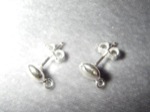 Post earrings are the traditional, post, through the hole style with a separate metal back piece, often called a butterfly for its shape.
Post earrings are the traditional, post, through the hole style with a separate metal back piece, often called a butterfly for its shape.
